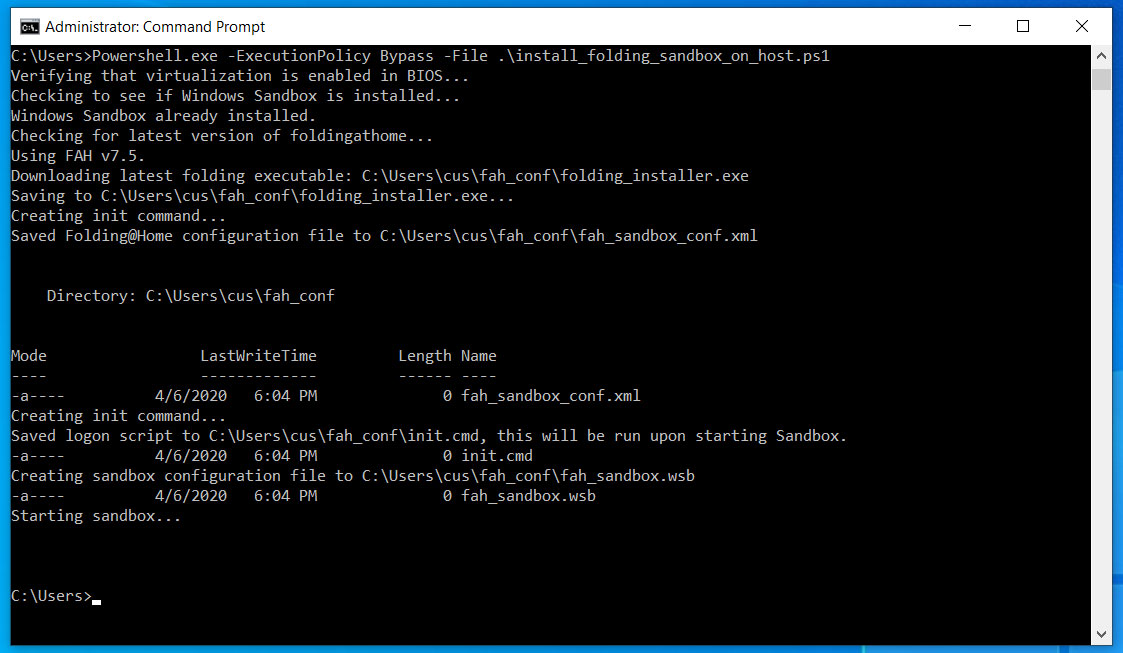
PowerShell script installing Folding@Home
When executed, the script will perform the following steps to get you up and running:
IT Articles - H 2020 1 2 3 4 5 6 7 IT List - H 2021 2020 2019 2018 1
Microsoft script installs Folding@Home in Windows 10's Sandbox
12.4.2020 Bleepingcomputer IT
Microsoft has released a PowerShell script that allows you to quickly start donating your CPU cycles to the Folding@Home project by deploying the program in the Windows 10 Sandbox.
The Folding@Home project is a distributed computing project that allows people to donate their CPU cycles to simulate the folding of proteins to research diseases and news drugs and treatments.
This project has become immensely popular since the Coronavirus outbreak, and with malware impersonating the program, Microsoft has released a PowerShell script that lets you quickly and securely get up and running with Folding@Home.
This is done through the Windows Sandbox feature that lets you launch a virtual machine that can be used to run programs without the risk of infecting your normal Windows 10 operating system.
Quickly setup Folding@Home in the Windows Sandbox
To start using Folding@Home in the Windows Sandbox, you can download the install_folding_sandbox_on_host.ps1 PowerShell script and save it to your computer.
Once downloaded, open a PowerShell administrator prompt and execute the following command to setup Windows Sandbox, deploy the Folding@Home client, and join the Windows_Sandbox Folding@Home team anonymously:
Powershell.exe -ExecutionPolicy Bypass -File .\install_folding_sandbox_on_host.ps1
You can use this command instead to join the Windows_Sandbox team under a particular name:
Powershell.exe -ExecutionPolicy Bypass -File .\install_folding_sandbox_on_host.ps1 -username [your username]
PowerShell script installing Folding@Home
When executed, the script will perform the following steps to get you up and running:
Check if Windows Sandbox is installed and if not install it. This feature is only available on Windows 10 Pro or Enterprise Insider builds 18362 or later.
Download the latest Folding@Home installer.
Create a configuration file for Folding@Home. This configuration file will automatically add you to Microsoft's windows_sandbox Folding@Home team.
Launches the Windows Sandbox and automatically starts the Folding@Home client with the configured configuration file.
When done, Windows Sandbox will automatically be launched and the Folding@Home client will be started as seen below.
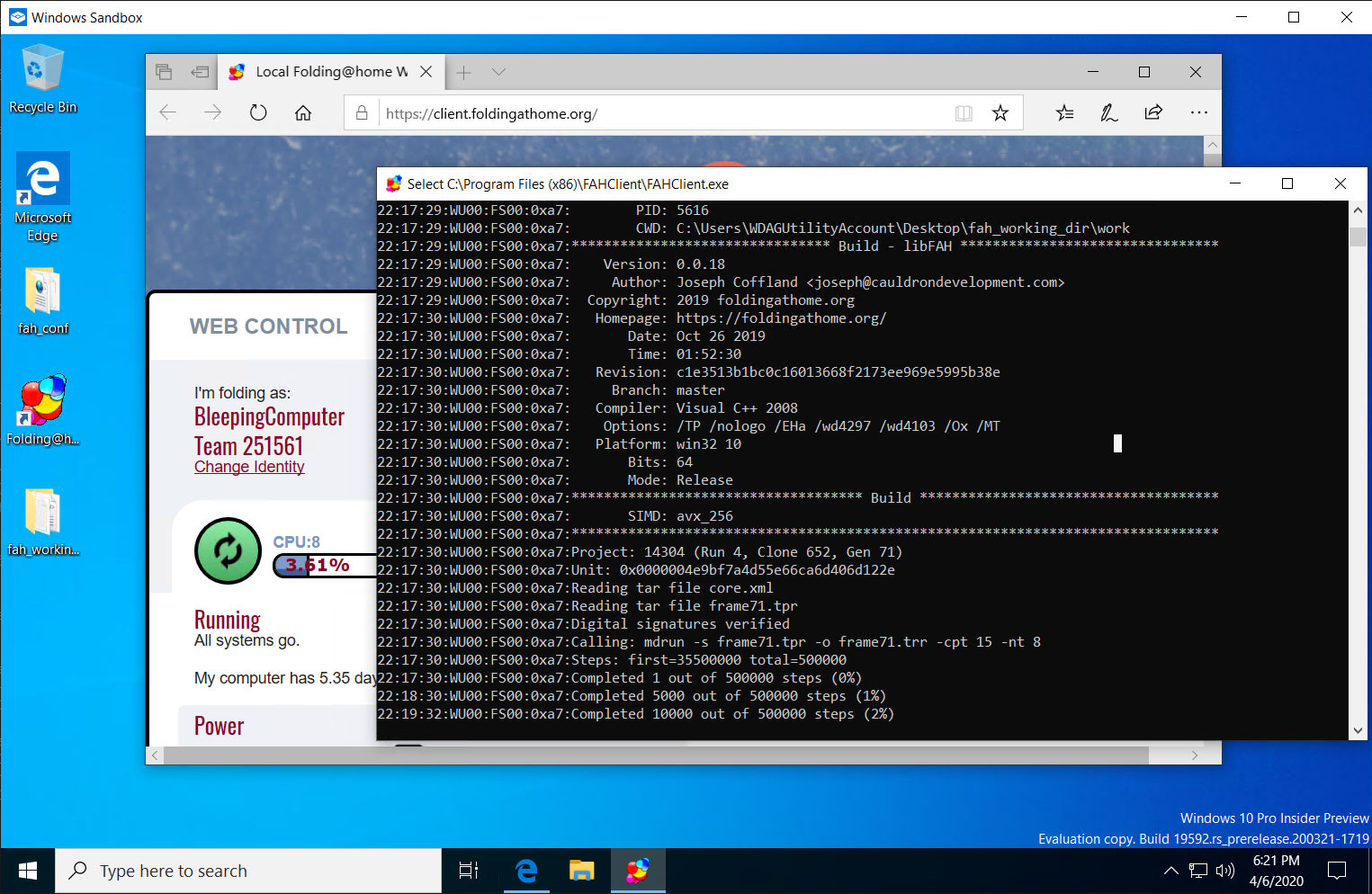
Folding@Home in the Windows Sandbox
By default, this PowerShell script will create a Folding@Home configuration file that automatically adds you to Microsoft's windows_sandbox Folding@Home team. If you want to appear as a specific name under their team, make sure you use the second PowerShell command listed above to specify a user name.
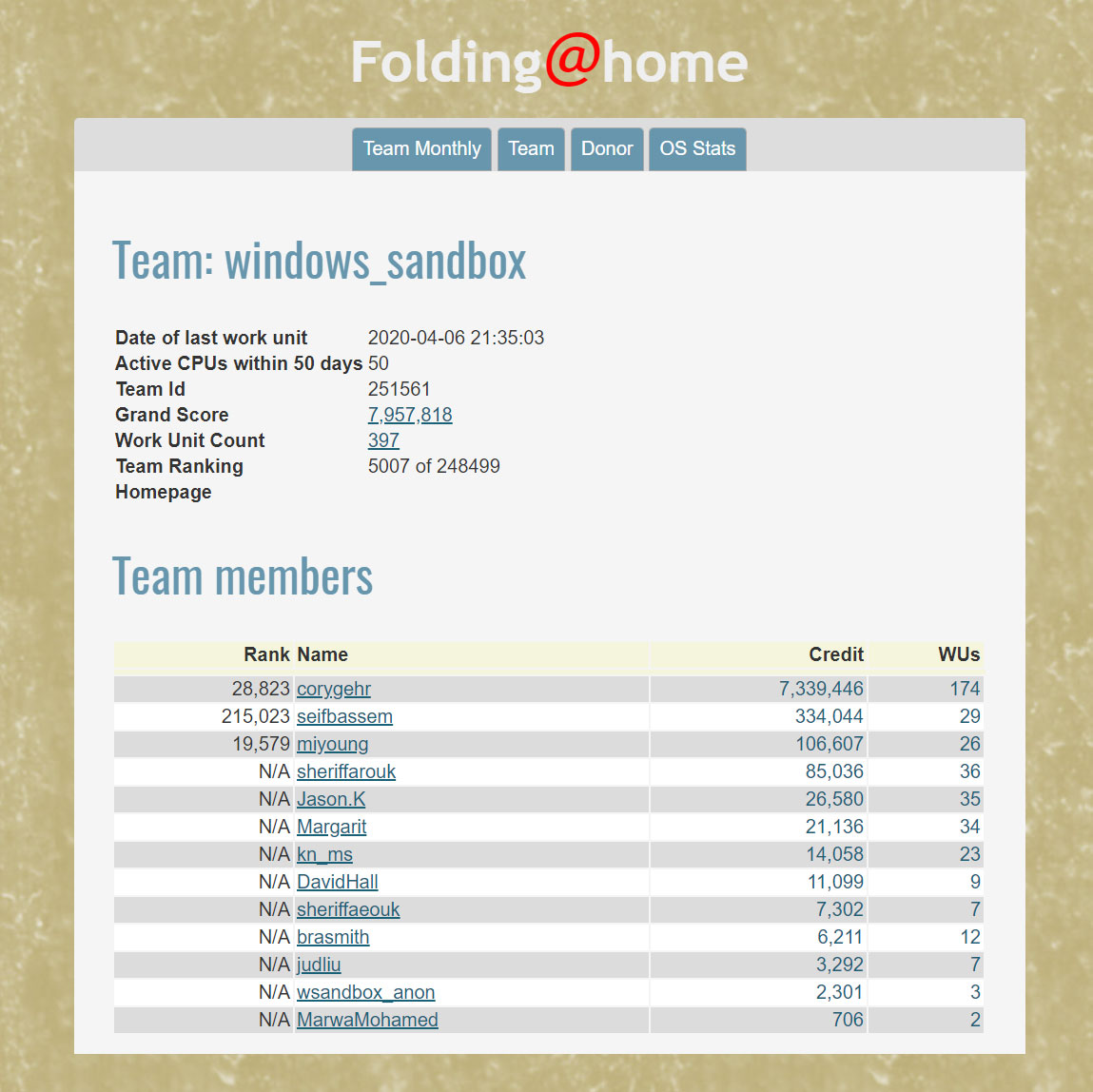
Microsoft's windows_sandbox Folding@Home team
Microsoft's PowerShell script makes it easy to get started using Folding@Home and contribute spare CPU to a great project researching the Coronavirus and other diseases.
The best part is that you can simply close the Windows Sandbox when done and no installed files will be left installed behind.
When you are ready to contribute again, you can simply launch the PowerShell script to start donating your CPU again.
WinRAR 5.90 Final Released For Windows, Mac, Linux, and Android
4.4.2020 Bleepingcomputer IT
WinRAR 5.90 Final has been released with numerous performance improvements and bug fixes for Windows, Mac, Linux, and Android.
For those not familiar with WinRar, it is an archiving software from RARLAB that supports the ARJ, BZIP2, CAB, GZ, ISO, JAR, LHA, RAR, TAR, UUE, XZ, Z, ZIP, ZIPX, 7z, 001 (split) archive formats.
WinRAR is distributed as trialware, which means that anyone can use it as a full-featured product before purchasing it.
WinRAR 5.90 offers quite a few performance improvements such as additional CPU support and a greater amount of threads. The full changelog can be read below.
1. RAR compression speed is improved for CPUs with 16 and more cores.
2. "Fastest" method (-m1 command line equivalent) typically achieves
a higher compression ratio for highly compressible data types
when creating RAR5 archives.
3. Maximum number of utilized threads is increased from 32 to 64.
Command line -mt switch accepts values from 1 to 64.
4. "Multithreading" parameter on "General" page of WinRAR settings
is replaced with "Threads" input field, where you can specify
the desired number of CPU threads. It can take values from 1 to
maximum number of available logical CPU units.
5. WinRAR displays packed and unpacked folder sizes when browsing
archive contents.
6. "Total folders" field is added to list of archive parameters
displayed by WinRAR "Info" command. Same field is added to
"Archive" page in archive properties in Windows Explorer.
7. Window including a progress bar and "Cancel" button is displayed
if reading archive contents takes noticeable time.
It can be useful for archive formats with slower access to contents,
such as large TAR based archives like .tar.gz and tar.bz2.
8. Archiving and extraction progress windows, also as progress windows
for some other commands, can be resized.
9. "Repair" performance for RAR5 archives with recovery record
and without data shifts is improved. It deteriorated in WinRAR 5.80
and is now restored to original level.
10. Password prompt is not issued when performing recovery record based
repair for RAR5 archives with encrypted file names.
This command can be performed without providing a password.
11. If folder for converted archives in "Convert archives" command
does not exist, WinRAR attempts to create it. Previous versions
failed to create converted archives in non-existent destination folder.
12. Added extraction support for GZIP archives with optional header
checksum field.
13. Bugs fixed:
a) "Repair" command could erroneously display "Recovery record is
corrupt" message when processing an archive with valid recovery
record. This message did not prevent further repair operation;
b) if quick open information option was set to "Do not add" in default
compression profile and this profile was loaded by some command
or dialog, WinRAR ignored quick open information when browsing
contents of RAR archives. For example, it happened after opening
archiving or password dialogs;
c) Ctrl+C "Copy" shortcut key did not work in archive comment window;
d) if "Put each file to separate archive" and "Archives in subfolders"
options were set, WinRAR ignored the destination path specified
in archive name field.
Grammarly is Now Available for Microsoft Word on Mac
4.4.2020 Bleepingcomputer IT
Grammarly has announced that its AI-driven writing assistant is now available for Mac users as an add-in for Microsoft Word.
For years, Grammarly has been available as a stand-alone product, a browser extension, and an add-in for Microsoft Word for Windows. Mac users, though, who wanted to integrate the writing assistant into Word for Mac were not able to do so.
Today, Grammarly has announced that their add-in for Word for Mac is now generally available for download.
"Grammarly for Microsoft Word has been available for some time, but until now, it was only compatible with the Windows version of Word. We heard loud and clear that you needed a Mac version, so we’ve been hard at work to make that happen. And if you’re a fan of Word Online, we’re happy to tell you that Grammarly now works there, too!," Grammarly's announcement stated.
Just like Word for Windows, the Mac add-in will display grammatical, spelling, and rewrite suggestions as you type based on the tone you wish to set for the document.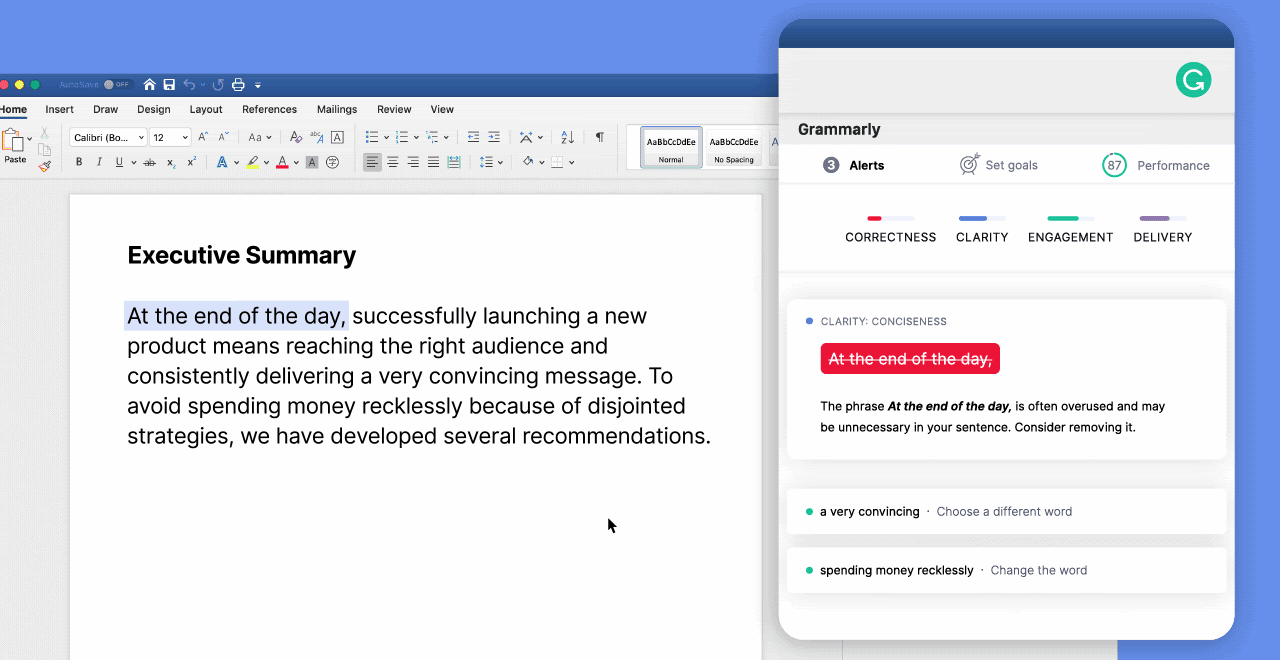
For Mac users who want to give it a try, you can download the add-in at the Grammarly for Microsoft Word and Outlook page.
Google Resumes Chrome Releases on an Adjusted Schedule
29.3.2020 Bleepingcomputer IT
Google today announced that Chrome and Chrome OS releases will be resumed on an adjusted schedule after previously pausing them due to employees having to work from home during the novel coronavirus pandemic.
The Google Chrome development team is currently working remotely throughout the novel coronavirus outbreak with development efforts being focused on releasing Chrome v81, the next stable release, on April 7.
This schedule page can be checked for accurate release dates for future Google Chrome milestones — dates for M84 and beyond can still be changed at any given time.
The new release schedule is as follows:
M83 will be released three weeks earlier than previously planned and will include all M82 work as we canceled the M82 release (all channels).
Our Canary, Dev and Beta channels have or will resume this week, with M83 moving to Dev, and M81 continuing in Beta.
Our Stable channel will resume release next week with security and critical fixes in M80, followed by the release of M81 the week of April 7, and M83 ~mid-May.
We will share a future update on the timing of the M84 branch and releases.
"We continue to closely monitor that Chrome and Chrome OS are stable, secure, and work reliably," Google's blog post reads.
"We’ll keep everyone informed of any changes on our schedule on this blog and will share additional details on the schedule in the Chromium Developers group, as needed."
Chrome v82 is off the table
Google announced a week ago that they will no longer work on Chrome 82 development because of the new release schedule and will skip to Chrome 83 instead.
This is now confirmed by the Chrome milestones schedule page that only lists the 81, 83, and 84 builds, with build 82 being jumped because of COVID-19 adjustments.
After Chrome releases were paused, Google said that they will prioritize security updates that will be released as Chrome v80 updates.
"We’ll continue to prioritize any updates related to security, which will be included in Chrome 80," Google said.
Google Chrome 80.0.3987.149 was released right after the company announced the Chrome v81 delay, with security fixes for 13 high severity vulnerabilities.
Google Chrome Adding Option to Always Show Full URLs
29.3.2020 Bleepingcomputer IT
Google is working on providing Chrome users with an option to set the browser to always show full URLs for all websites they visit.
At the moment, the option to always show full URLs can only be enabled using an experimental flag on Google Chrome Canary version 83 and it can be accessed via the Omnibox context menu by Mac, Windows, Linux, and Chrome OS users.
As we'll also show below, Google has a long history of working towards hiding the protocol and of what they call trivial subdomains or special-case subdomains from the URLs displayed in Chrome's address bar.
How to reenable full URLs in Chrome Canary
Windows, Mac, Linux, and Chrome OS users who utilize Google's Chrome Canary can configure their browsers to show the full URLs for all websites using the omnibox-context-menu-show-full-urls experimental flag.
The newly added flag is designed to provide Chrome Canary users with an omnibox context menu option that will prevent URL elisions aka the removal of some URL elements Google considers not important.
To do this, you have to go through the following steps:
1. Go to chrome://flags/#omnibox-context-menu-show-full-urls.
2. Click the drop-down menu on the right side of the flag to select 'Enabled'
3. Restart the web browser.
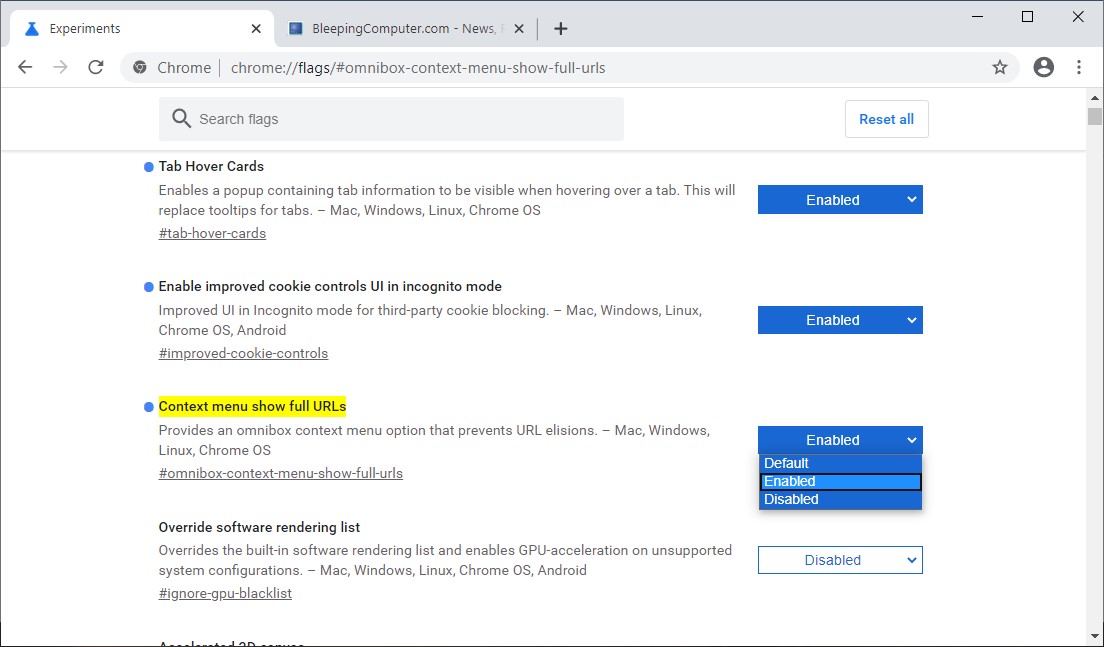
Enabling the Chrome 'show full URLs' option
Afterward, you will be able to find an 'Always show full URLs' Omnibox context menu option that will tell Chrome to display the entire URL, without eliding any components.
A slimmed-down or early version of this option has already been rolled out to some users of Google Chrome version 80, as BleepingComputer was also able to confirm.
The 'Show URL' option allows them to enable full URLs on a per-page basis — the setting doesn't stick though as it will be forgotten after refreshing the page.
As it is currently being tested Google Chrome Canary version 83.0, the 'Always show full URLs' Omnibox context menu option will most likely roll out once the stable version Google Chrome will be released.
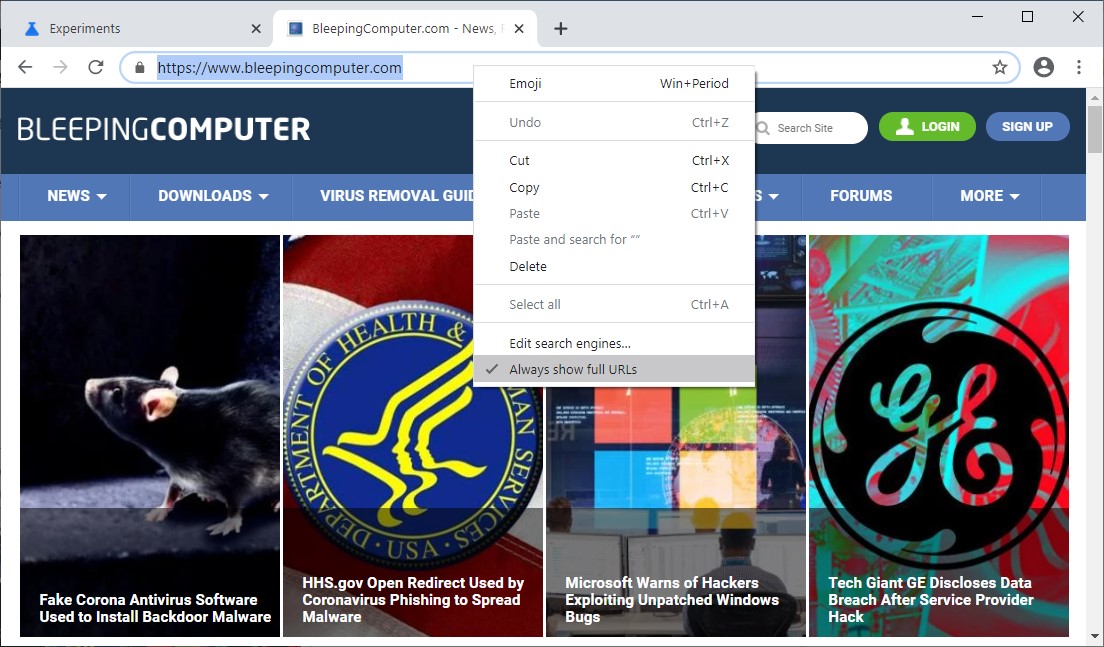
Full URL in the address bar
Out of sight, out of mind
The WWW and M subdomains together with the protocol part (e.g., HTTP, HTTPS, or FTP) of the URL were initially stripped from Chrome's address bar with the release of Chrome 69 in September 2018.
Following users' outcry opposing this change, Google reversed the decision but, once again, hid them from URLs shown in the address bar for users of Chrome 76 on desktop and Android devices.
"The Chrome team values the simplicity, usability, and security of UI surfaces," as product manager Emily Schechter said at the time.
"To make URLs easier to read and understand, and to remove distractions from the registrable domain, we will hide URL components that are irrelevant to most Chrome users," she added. "We plan to hide 'https' scheme and special-case subdomain 'www' in Chrome omnibox on desktop and Android in M76."
Google did leave in an option to have it reversed, as users were still able to enable full URLs in the Omnibox by enabling the temporary-unexpire-flags-m76 flag. However, that lasted until Chrome 79 was released as that flag was permanently removed.
Eric Lawrence 🎻
@ericlaw
TIL (Thanks Emily!) that if you have the Suspicious Site Reporter browser extension enabled, Chrome 76 doesn't hide the "https://www" at the front of the omnibox.
16
10:33 PM - Jul 31, 2019
Twitter Ads info and privacy
See Eric Lawrence 🎻's other Tweets
The only way to see the full website address while using Chrome 79 or a newer version is to click twice in the address bar to edit the URL or to install Google's Suspicious Site Reporter Chrome extension.
More recently, Google has also started testing displaying the search query in the Chrome address bar instead of the actual URL of the loaded page when performing searches on Google.
This experimental feature is currently called "Query in Omnibox" and it has been available as a Google Chrome flag since Chrome 71 but it is disabled by default.
"People have a really hard time understanding URLs. They’re hard to read, it’s hard to know which part of them is supposed to be trusted, and in general, I don’t think URLs are working as a good way to convey site identity," Adrienne Porter Felt, Chrome's engineering manager said in a Wired interview,
"So we want to move toward a place where web identity is understandable by everyone—they know who they’re talking to when they’re using a website and they can reason about whether they can trust them."
TeamViewer Stops Commercial Use Checks in Coronavirus-Affected Regions
29.3.2020 Bleepingcomputer IT
TeamViewer has stated that they will stop performing checks for commercial use of their remote control product in regions heavily affected by the Coronavirus.
TeamViewer is a remote control software that is commercial organizations can purchase to offer remote support and for non-commercial, or personal, users to use for free to control their computer or help friends and family.
Even personal use of TeamViewer is meant to be for free, some users are erroneously detected as being used for commercial use.
When this happens, their sessions will be disconnected and they are prompted to purchase the program with various alerts, some comical, as shown below. 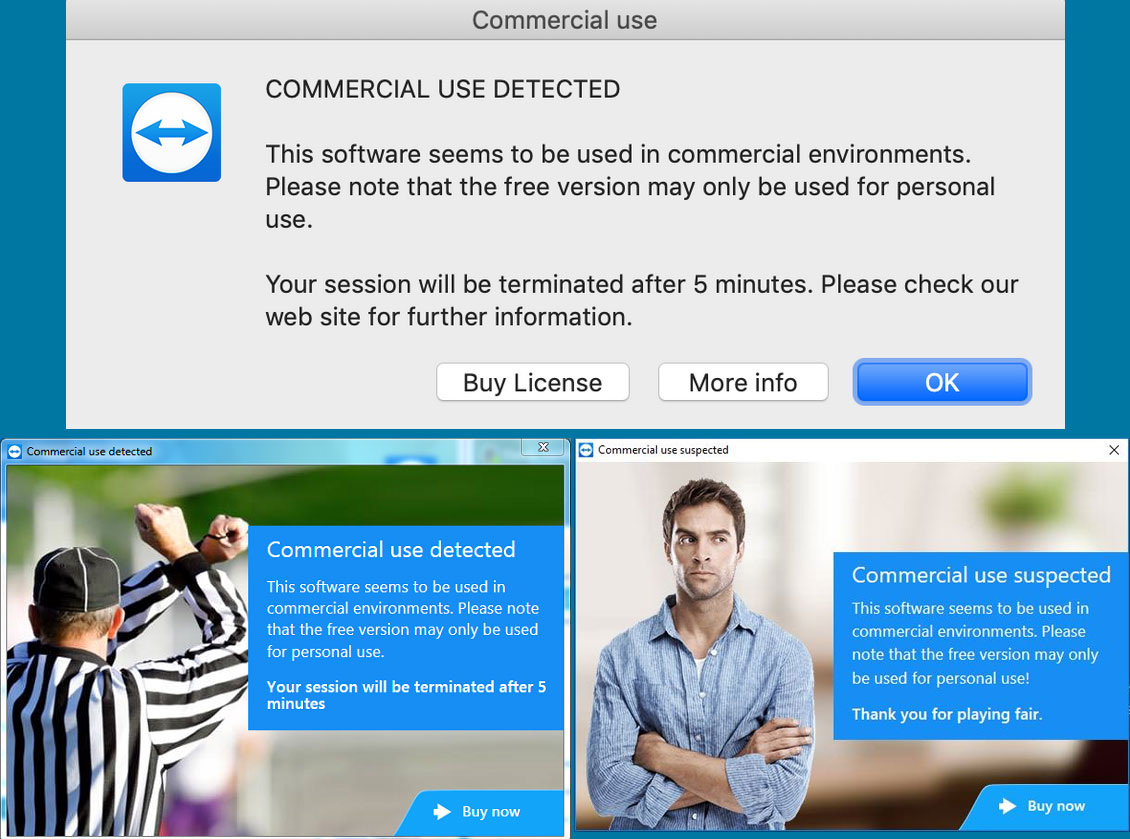
TeamViewer Commercial use detected alerts
With more people working from home, friends and family helping each other with technical issues, or some using it for commercial reasons without a license, many TeamViewer users have started to receive the dreaded "Commercial use detected" alerts.
Once they receive this alert, their TeamViewer ID is added to a bucket of users who will continue to see this message when using TeamViewer. The only way to use TeamViewer again for personal use is to submit a request to have their TeamViewer ID reset.
After reaching out to the TeamViewer, TheRegister was told that TeamViewer is stopping the checks for commercial users in regions heavily affected by the Coronavirus.
"We have stopped checking connections for commercial use in heavily affected regions like China and Italy already some weeks ago and are currently implementing that for lots of other affected countries including UK," TeamViewer told TheRegister.
In a statement to BleepingComputer, TeamViewer stated that the USA is region where commercial checks are not being conducted anymore.
"Yes, the US is also included now in the regions where we don’t check commercial use anymore to allow individuals (not commercial companies) to use TeamViewer in the current crisis situation for whatever purpose they need it," TeamViewer told BleepingComputer.
Update 3/25/20: Added TeamViewer's statement about the USA.
YouTube and Amazon Also Lowering Video Quality in Europe
22.3.2020 Bleepingcomputer IT
Following in the footsteps on Netflix, Amazon and YouTube have also agreed to lower the video streaming quality of their services to prevent European network infrastructure from becoming overburdened.
With people increasingly turning to the Internet for entertainment and information during the Coronavirus pandemic, the European Union has asked that streaming providers reduce the quality of its videos to standard definition (SD) to reduce the burden on Internet infrastructure.
"As a result of social distancing measures put in place across Europe to fight the Coronavirus pandemic, the demand for Internet capacity has increased, be it for teleworking, e-learning or entertainment purposes. This could put networks under strain at a moment when they need to be operational at the best possible level. In order to prevent congestion and to ensure the open Internet, Internal Market Commissioner Thierry Breton has called on the responsibility of streaming services, operators and users. Streaming platforms are advised to offer standard rather than high definition and to cooperate with telecom operators."
Yesterday, Netflix agreed to lower the bit rate of their streaming videos by 25% for the next 30 days.
Today, both Amazon and Google stated that they would also reduce the quality of streaming videos for their platforms as well.
"We support the need for careful management of telecom services to ensure they can handle the increased internet demand with so many people now at home full-time due to COVID-19. Prime Video is working with local authorities and Internet Service Providers where needed to help mitigate any network congestion, including in Europe where we’ve already begun the effort to reduce streaming bitrates whilst maintaining a quality streaming experience for our customers," a Prime Video spokesperson told BleepingComputer.
In a statement to Reuters, Google has also stated that they will reduce the quality of YouTube video to SD in or
"We are making a commitment to temporarily switch all traffic in the EU to standard definition by default," Google told Reuters.
While Netflix has stated that they plan to reduce the quality for only 30 days, there is a good chance that this reduction in quality will last longer if necessary.
Audible Stories Give Parents a Break With Free Audio Books for Children
22.3.2020 Bleepingcomputer IT
Audible has launched a new service called Audible Stories where children and teenagers can listen to a huge selection of stories in six different languages for free.
With the launch of their new service, Audible Stories says these audiobooks will be free for as long as school is out to help continue learning and take a break from these stressful times.
"For as long as schools are closed, we're open. Starting today, kids everywhere can instantly stream an incredible collection of stories, including titles across six different languages, that will help them continue dreaming, learning, and just being kids," Audible Stories states on their home page,
Included in this offer is a wide range of books ranging from elementary school stories to classic stories for teenagers in high school.

Some of the books available on Audible Stories
The available audiobooks include classics such as Winnie-the-Pooh and Stone Soup for younger kids to White Fang, The Call of the Wild, Brave New World, and Roots for the older ones.
With school out, these free audiobooks come at a great time as they not only can be fun to listen to for the whole family but can also give parents a break to get some work done.
Netflix Reduces Video Quality in Europe by 25% to Lower Load
22.3.2020 Bleepingcomputer IT
Netflix is reducing the quality of its streamed shows and movies in Europe for the next 30 days to reduce congestion on Internet infrastructure.
With European countries on national lockdowns, mandated curfews, and people performing social-isolation during the pandemic, the EU commission has been concerned that the increased video streaming would overburden Internet infrastructure.
Today, Internal Market Commissioner Thierry Breton called on streaming providers to reduce the quality of the video streams to standard definition (SD) rather than high definition (HD) to reduce the bandwidth required for streaming a show.
"As a result of social distancing measures put in place across Europe to fight the Coronavirus pandemic, the demand for Internet capacity has increased, be it for teleworking, e-learning or entertainment purposes. This could put networks under strain at a moment when they need to be operational at the best possible level. In order to prevent congestion and to ensure the open Internet, Internal Market Commissioner Thierry Breton has called on the responsibility of streaming services, operators and users. Streaming platforms are advised to offer standard rather than high definition and to cooperate with telecom operators."
After a conversation with Commissioner Thierry Breton and Reed Hastings, Netflix has agreed to reduce the bit rate on all streams in Europe by 25% for the next 30 days.
"Following the discussions between Commissioner Thierry Breton and Reed Hastings - and given the extraordinary challenges raised by the coronavirus - Netflix has decided to begin reducing bit rates across all our streams in Europe for 30 days. We estimate that this will reduce Netflix traffic on European networks by around 25 percent while also ensuring a good quality service for our members", Netflix told BleepingComputer.
BleepingComputer has also contacted other streaming providers such as Hulu and Amazon to see if they would reduce their bit rate but have not heard back at this time.
Microsoft Teams Reaches 44M Daily Users After 12M Weekly Gain
22.3.2020 Bleepingcomputer IT
Microsoft announced today that its Teams collaboration service experienced a huge usage spike with 12 million new daily active users being added within the last seven days, bringing the total to 44 million.
The newly added Microsoft Teams users are already behind more than 900 million call and meeting minutes each day during the last week.
"It’s very clear that enabling remote work is more important than ever, and that it will continue to have lasting value beyond the COVID-19 outbreak," Corporate Vice President for Microsoft 365 Jared Spataro said.
"We are committed to building the tools that help organizations, teams, and individuals stay productive and connected even when they need to work apart."
Microsoft Teams which is part of Microsoft's Office 365 enterprise subscription services was launched in November 2016 as a direct competitor to Slack's instant messaging platform.
Slack reported in October 2019 that it has reached over 12 million daily active users, lagging behind the 13 million users reported by Microsoft earlier, in July 2019 — Teams reached 20 million daily active users in November 2019.
Microsoft
✔
@Microsoft
Microsoft Teams' 44 million users have generated more than 900 million meeting minutes every day this week. As organizations adapt to remote work, we're helping users stay connected. https://msft.it/6005TdOZc
1,147
5:14 PM - Mar 19, 2020
Twitter Ads info and privacy
450 people are talking about this
Tens of thousands of users from hundreds of orgs
20 Microsoft Teams customers including Ernst & Young, SAP, Pfizer, and Continental AG currently have over 100,000 employees using the service on a daily basis, while Accenture has also added has 440,000 additional Teams users.
At the moment, employees from 93 Fortune 100 companies are using Microsoft's Teams service, while more than 650,000 other organizations have more than 10,000 Teams users in their ranks.
Microsoft says that only intentional actions like replying to messages, joining meetings, or opening files made by users on their desktop, mobile, or web Teams clients are taken into consideration when counting the number of active users.
Interactions such as minimizing the Microsoft Teams client or closing the application do not automatically tag the user as being active.
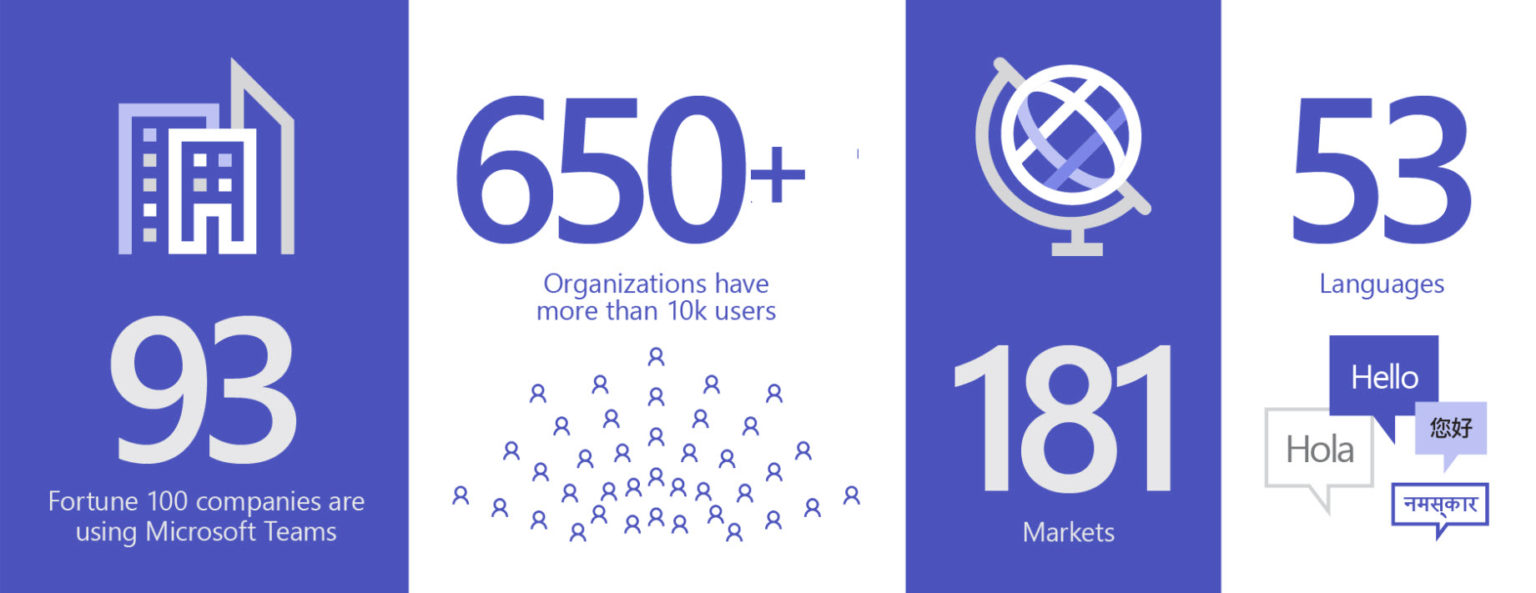
Image: Microsoft
New features rolling out
Microsoft also announced that new features are rolling out to Microsoft Teams users including automatic real-time noise suppression to reduce background noise during meetings.
Microsoft Teams users will also get support for offline and low-bandwidth usage making it possible to read messages even when using it without an Internet connection and in low-bandwidth network environments.
"Teams users will now be able to open Teams even when no network is available," Microsoft says. "You will be able to create and read messages, browse previously viewed channels, and to view calendar summaries."
"If conditions are too poor to send a message, Teams will notify users of this and then save the message until the user has returned to a functioning network. This functionality is coming to Teams in the next few weeks."

Raise hands feature (Microsoft)
Users will also be able to draw attention while in Teams meetings using a new "raising hands" feature that makes it easy to actively take part in large meetings.
"Everyone will see a visual cue on the attendee’s video feed, as well as in the participant list, and can be sure to give them the room to participate in the conversation at hand," Microsoft adds.
The number of members in individual teams will also be raised from 5,000 to 10,000 users during the incoming updates in the next few weeks, just as the number of people being able to join a group chat which can now accommodate up to 250 users.
Microsoft Teams goes free, outage issues
Microsoft also announced earlier this month that Microsoft Teams will be free during the next six months to help orgs' to move towards a remote workplace during the COVID-19 pandemic.
"At Microsoft, the health and safety of employees, customers, partners and communities is our top priority," Microsoft EVP and President JP Courtois said. "By making Teams available to all for free for six months, we hope that we can support public health and safety by making remote work even easier."
At the start of this week, Microsoft Team also experienced an outage caused by the huge influx of new users, affecting both EU and US users on March 16 and March 17, with reports mentioning messages not being sent, the admin portal being unreliable, and team member management not working properly.
Microsoft 365 Status
@MSFT365Status
We're investigating messaging-related functionality problems within Microsoft Teams. Please refer to TM206544 in your admin center for further details. ^JP
253
9:50 AM - Mar 16, 2020
Twitter Ads info and privacy
291 people are talking about this
Microsoft resolved the on March 17 and determined that it was a caching issue within one of Microsoft Teams infrastructure's components.
The company is also currently working on scaling down select non-essential Office 365 capabilities in response to increased demand and the increasing number of new Microsoft 365 customers.
"Microsoft is actively monitoring performance and usage trends to ensure we're optimizing service for our customers worldwide, and accommodating new growth and demand," a Microsoft spokesperson told BleepingComputer.
"At the same time, these are unprecedented times and we’re also looking at what steps we can take to proactively prepare for these high-usage periods."
Xbox Live and Support.xbox.com Experiencing an Outage
21.3.2020 Bleepingcomputer IT
Microsoft is currently experiencing an outage where some users are unable to login to Xbox Live, have issues with matchmaking, and are unable to access support.xbox.com.
At approximately 5:00 PM EST, users started reporting that they were unable to login to Xbox Live, access their saved games, or have issues with matchmaking. Since then, users have also been having issues opening support.xbox.com.
Microsoft has confirmed these issues in the Xbox Support Twitter account as can be seen below.
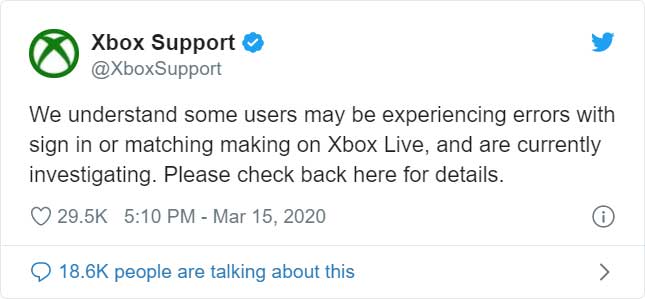
Tweet about Xbox Live being down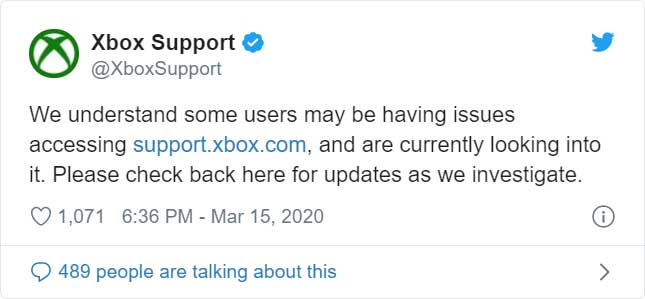
Tweet about support.xbox.com being down
When users try to access support.xbox.com, they will simply be greeted with the animated Xbox loading circle as seen below.
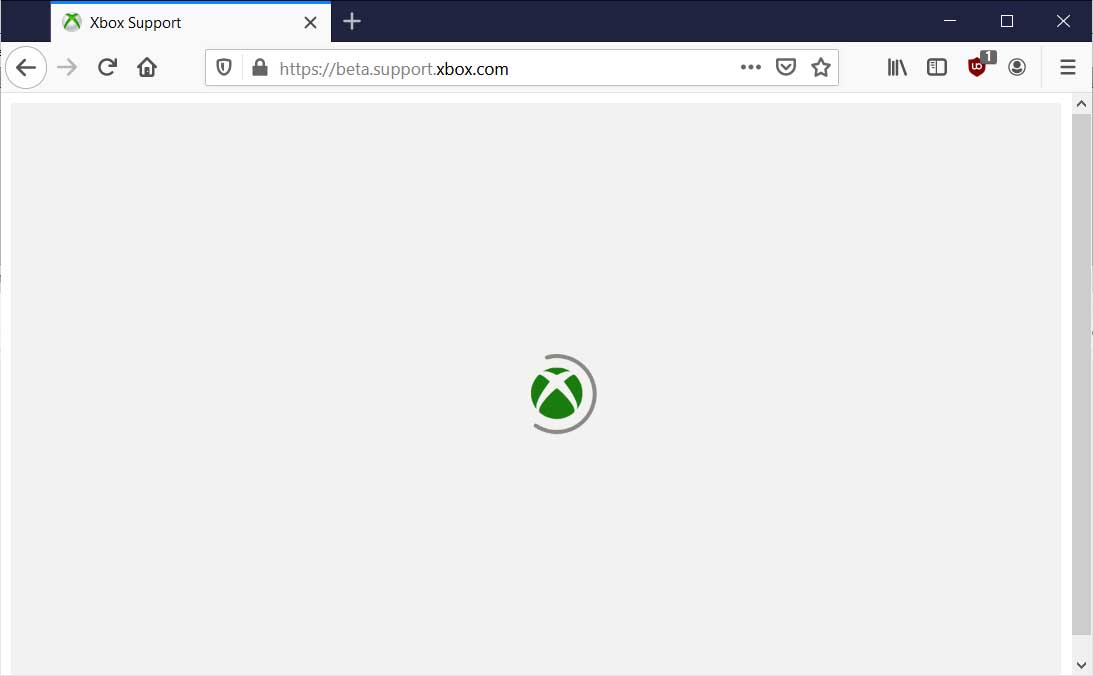
Support.xbox.com outage
At approximately 7:30 PM EST, service was restored for both Xbox Live and support.xbox.com
Folding@Home Now Has 23 Coronavirus Projects, Donate CPU Power!
21.3.2020 Bleepingcomputer IT
The Folding@home distributed computing project has added twenty new Coronavirus (COVID-19) projects since earlier this week that uses donated CPU or GPU power to research new treatment methods.
Folding@home allows researchers to use donated CPU and GPU cycles to simulate protein folding to research new drug opportunities against diseases and a greater understanding of various diseases.
Last week, we reported that the Folding@home added three new projects (11741, 11742, and 11743) that were being used to research the COVID-19 virus and how to create potential drug therapies
Since we last looked on March 9th, 2020, researchers from Memorial Sloan Kettering Cancer Center, Washington University in St. Louis, and Temple University have added 20 new projects, for a total of 23, that are all being used to analyze the proteins of Coronavirus virus.
"To help tackle coronavirus, we want to understand how these viral proteins work and how we can design therapeutics to stop them," Folding@home's announcement stated.
The Current Folding@home project IDs that correspond with Coronavirus (COVID-19) research are 11741, 11742, 11743, 11744, 11745, 11746, 11747, 11748, 11749, 11750, 11751, 11752, 11759, 11760, 11761, 11762, 11763, 11764, 14328, 14329, 14530, 14531, and 14532.
Getting started with Folding@home
To get started with Folding@home, download the Folding@home client and install it.
Once installed, Folding@home will automatically be configured to lightly use your computer's CPU and GPU processing power to perform protein-folding when you log into Windows. A GPU will only be used if it's hardware and software is supported.
If you wish to increase the amount of CPU and GPU utilization, you can right-click on the Folding@home icon in your Windows system and select either from 'Light', 'Medium', or 'Full'.
It should be noted that the higher the intensity you select, the slower your computer will become, the more heat it will generate, and the more electricity it will use.
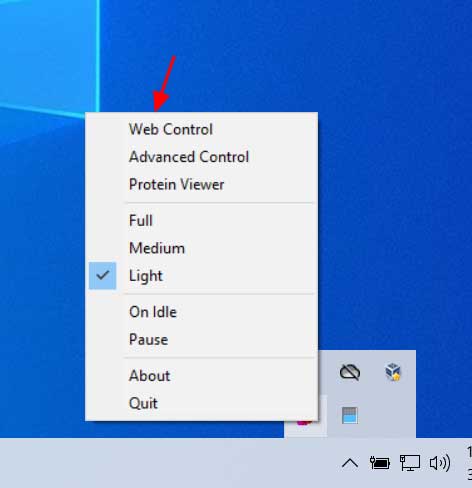
Folding@home options
If you want to check what project you are currently working on or change some of the program's settings via a web GUI, you can select the 'Web Control' option as shown in the image above.
This will open a web page showing your current work-in-progress, your settings, and the project ID you are currently working on. To support Coronavirus projects, make sure to support research fighting 'Any Disease'.
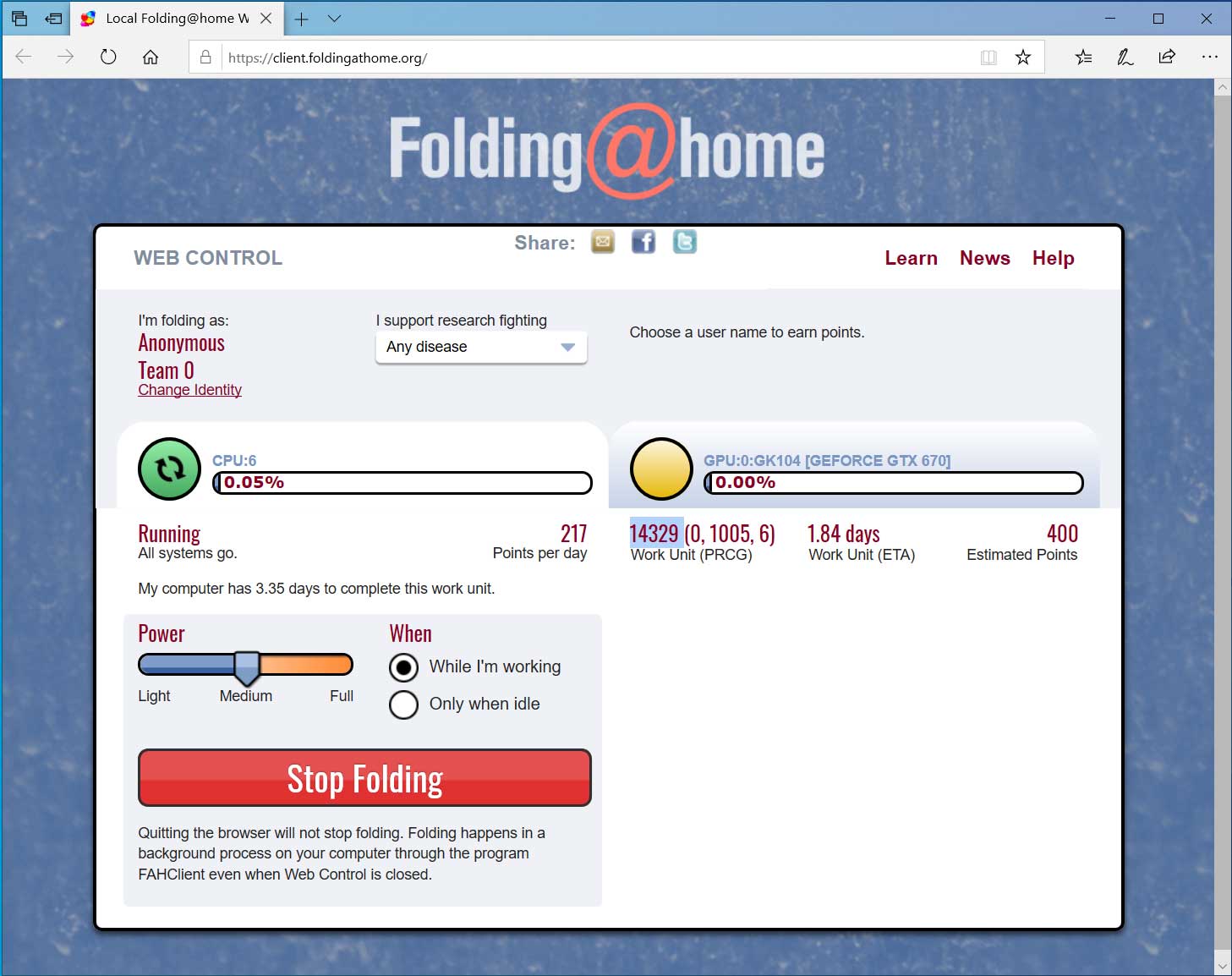
Folding@Home
After determining the project ID number, you can look up the project ID you are working on here. For example, in the image above you can see that the project ID is 14329, which is for Coronavirus/COVID-19 research.
The Folding@home project has said that due to the increasing interest in the project and CPU and GPU cycles being donated, it may take some time before you receive a job to work on.
"Each simulation you run is like buying a lottery ticket. The more tickets we buy, the better our chances of hitting the jackpot. Usually, your computer will never be idle, but we’ve had such an enthusiastic response to our COVID-19 work that you will see some intermittent downtime as we sprint to setup more simulations. Please be patient with us! There is a lot of valuable science to be done, and we’re getting it running as quickly as we can," Folding@home stated.
If you have an idle computer sitting around doing nothing, please contribute it to the project. Who knows, the data you are assigned and solve could be what helps to create a cure!